How do you take your data collection for speech therapy? Do you use speech therapy data collection forms? I have tried several different methods over the years! A big factor is deciding if you want digital data collection or a paper form for data collection? Last year I did digital, but this year I’m doing paper! I think both options are great!
In fact, here are 5 ideas for IEP data collection –

1. Sticky Notes Method
I feel like this is probably a method that you’ve tried before – even if it was on accident! It is so easy to just grab a sticky note and go! I love the convenience of sticky note data collection, but the downfall is definitely a lack of organization. But that can be remedied!
We need to have a place to store the sticky notes! A simple way to do this is to put blank pieces of paper inside your students’ working folders. Then you can line up the sticky notes there as you go and add in details like date/time/units for your documentation and billing. You may want to add tape to the sticky notes to ensure that they don’t fall off and last an entire school year!
2. Data Collection Form Method
This is another traditional approach. You print the form once, make a million copies, and then they are ready to go for each of your students! I like to store mine in their working folders so that I can easily access them. Other people prefer to create a big binder full of all the forms and separate by student/grade/group using tabs! Whatever makes the most sense to you!
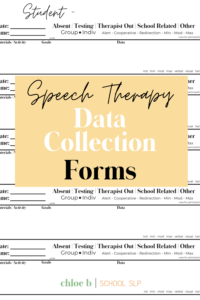
I designed my data collection forms to have everything that I needed in one place – including attendance records! There just didn’t seem to be a point in keeping attendance and data separate considering obviously the student was present if I have a note for them for that day.
Additionally, I wanted to streamline the process to make it as easy and efficient as possible. I love using my pen to just circle something rather than having to write it all out. That’s why the following sections are circle-able:
- Reason for absence (Absent, Testing, Therapist Out, School Related, Other)
- Tx Type (Group, Individual)
- Subjective part of SOAP note (Alert, Cooperative, Redirection, Min, Mod, Max cues for participation)
- Level of cue/prompt needed (Independent, Min, Mod, Max, Verbal, Visual, Tactile)
There is also free space to write goals (I do shorthand such as ‘mmw’ for multiple meaning words task), activities/materials used, and data collection. I like to use +/- so I wanted to make sure there was plenty of space for that! I personally love using my speech therapy data collection forms!
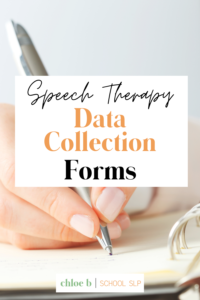
3. Digital Software (SLP Toolkit / SLP Now) Method
I am not affiliated with these brands, but I have personally used SLP Toolkit (for a year) before. Truthfully, if you have the money – these are awesome. It takes a good amount of setup time to get all of your students and their information in the software. But then you have it for as long as you pay for the subscription!
I liked all of the extras with SLP Toolkit such as the progress monitoring, copy/paste for Medicaid billing, and little assessments. It was also easy to trade kids back and forth with the other SLP at my school whenever we needed.
My only complaint was how costly it was! Both data collection programs have a lot to offer (SLP Now also provides literacy based materials) but I don’t want to depend on a subscription for my entire career!
That’s why I decided to make my own version! It’s digital with a lot of the same benefits – all made in Google Forms!
4. Google Forms Method
This can be a little complex, so I’m hoping to make a YouTube video in the near future that explains how to do it. Basically you will create a Google form for every student on your caseload using your email address #1.
On this Google form I included a part for date, start time, checkbox for type of session (15 minute individual, 30 minute individual, 15 minute group, 30 minute group), attendance (Present, Absent, Testing, Therapist Meeting, Other), a typing box for qualitative data, and then all of the student’s goals with a 0-10 scale underneath to document percentage.
Then…
I organized all of the Google forms that I made into folders in my Google drive. You can organize them by grade (what I did) or by therapy group. My friend who first introduced me to this method saves her therapy groups as shortcuts on her desktop. That way she can click on the shortcut and it pops up all of the kids in that group.
If that seems too complicated or your groups change a lot – I sent all of my Google forms to a different email (email #2) and gave them a Sunnymede Data Collection label.
That way I could keep my computer on all day with the email pulled up to just type or click each students name and complete the forms as I went.
I love that I barely had to type anything! It was so fast to just click-click-click on everything. And Google forms are free forever!
Would you like more info on the Google forms method? Comment below to let me know if you’d like a YouTube video explanation/tutorial!
I hope these data collection ideas for speech therapy were helpful! I’ve tried them all and you really can’t go wrong! It’s all about personal preference! What do you use for speech therapy data collection forms? Let me know in the comments below!
-Chloe B | School SLP
Looking for more on IEP Management? Check out this blog post on IEP at a Glance Sheet for working folders!


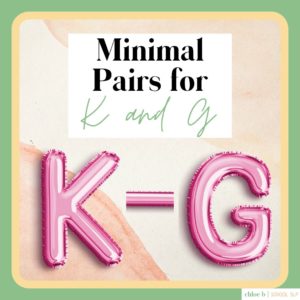
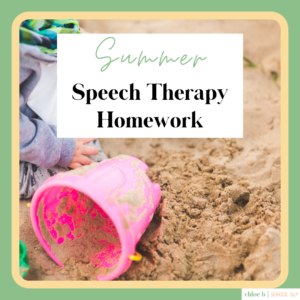
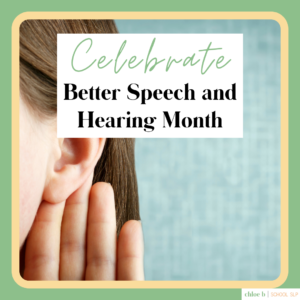

2 Responses